
In a parallelogram ABCD, two points P and Q are taken on diagonal BD such that $DP=BQ$(see the given figure). Show that:
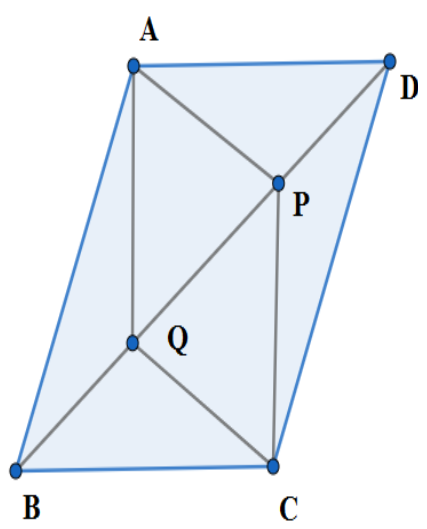
(i) $\Delta APD\cong \Delta CQB$ \[\]
(ii) $AP=CQ$ \[\]
(iii) $\Delta AQB\cong \Delta CPD$ \[\]
(iv) $AQ=CP$ \[\]
(v) APCQ is a parallelogram \[\]

Answer
557.7k+ views
Hint: We take equal alternate angles $\angle ADP=\angle CBQ$, opposite sides $AD=BC$ and the given equality $DP=BQ$ to prove $\Delta APD\cong \Delta CQB$ which gives us $AP=CQ$. Similarly we take equal alternate angles $\angle ABQ=\angle CDP$, opposite sides $AB=BD$ the given equality $DP=BQ$ to prove $\Delta AQB\cong \Delta CPD$ which gives us $AQ=CP$. The proofs of part (ii) and (iv) gives that APCQ is a parallelogram \[\]
Complete step-by-step solution
We know that the opposite sides of a parallelogram are equal and parallel. In parallelogram ABCD we have opposite sides AB and CD , AD and BC. Then we have;
\[\begin{align}
& AB=CD,AB||CD \\
& AD=BC,AD||BC \\
\end{align}\]
We also know that the measure of opposite angles in a parallelogram is equal. \[\]
(i) Let us observe the triangles APD and CBQ. Since we have $AD||BC$ and the diagonal BD as the transverse line, we have equal alternate angles$\angle ADP=\angle CBQ$. The opposite sides of parallelogram $AD=BC$ and we are given equal sides $DP=BQ$. We use side-angle-side congruence and conclude that $\Delta APD\cong CQB$. \[\]
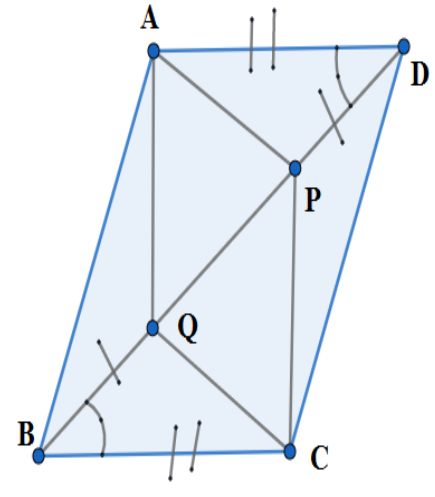
(ii) Since we have proved $\Delta APD\cong CQB$ the corresponding sides will be equal and hence sides opposite to $\angle ADP=\angle CBQ$ will be equal which means $AP=CQ$ \[\]
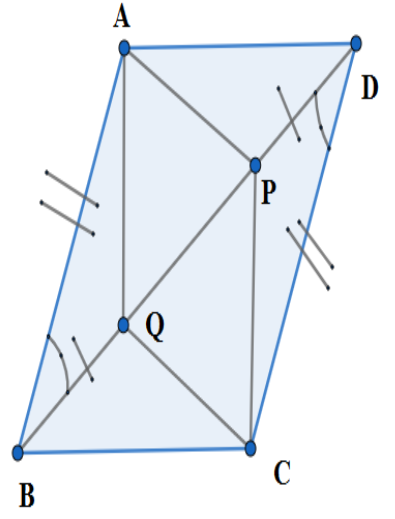
(iii) Let us observe the triangles AQB and CPD. We have the parallel sides of parallelogram $AB||CD$ and the diagonal BD as the transversal line where we have equal alternating angles$\angle ABQ=\angle CDP$. We have equal opposite sides $AB=CD$ and we are given in the question $DP=BQ$. We use side-angle-side congruence and conclude that $\Delta AQB\cong \Delta CPD$. \[\]
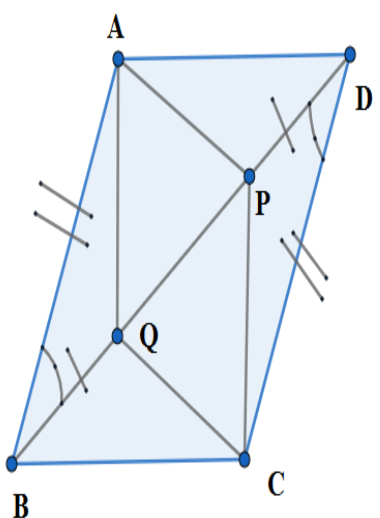
(iv) Since we have proved $\Delta AQB\cong \Delta CPD$ the corresponding sides will be equal and hence sides opposite to $\angle ABQ=\angle CDP$ will be equal which means $AQ=CP$ \[\]
(v)Since we have already proved $AP=CQ$ and $AQ=CP$ which are opposite sides of the quadrilateral APCQ, then APCQ is a parallelogram. \[\]
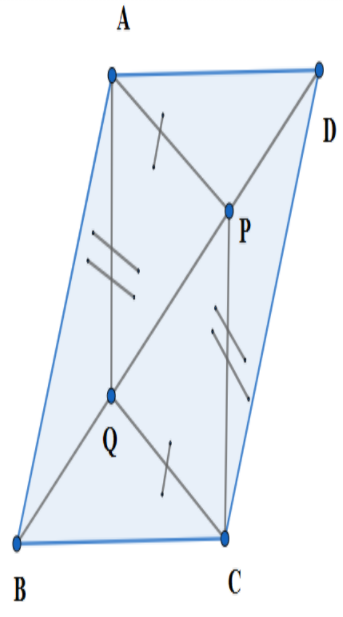
Note: We note that both pair of opposite sides have to be equal or parallel to make the quadrilateral a parallelogram; otherwise if one pair of sides are equal or parallel the quadrilateral is a trapezium. We can also directly prove APCQ is a parallelogram. We must not confuse between the similarity and congruence of a triangle if two triangles are similar or may not be congruent.
Complete step-by-step solution
We know that the opposite sides of a parallelogram are equal and parallel. In parallelogram ABCD we have opposite sides AB and CD , AD and BC. Then we have;
\[\begin{align}
& AB=CD,AB||CD \\
& AD=BC,AD||BC \\
\end{align}\]
We also know that the measure of opposite angles in a parallelogram is equal. \[\]
(i) Let us observe the triangles APD and CBQ. Since we have $AD||BC$ and the diagonal BD as the transverse line, we have equal alternate angles$\angle ADP=\angle CBQ$. The opposite sides of parallelogram $AD=BC$ and we are given equal sides $DP=BQ$. We use side-angle-side congruence and conclude that $\Delta APD\cong CQB$. \[\]

(ii) Since we have proved $\Delta APD\cong CQB$ the corresponding sides will be equal and hence sides opposite to $\angle ADP=\angle CBQ$ will be equal which means $AP=CQ$ \[\]

(iii) Let us observe the triangles AQB and CPD. We have the parallel sides of parallelogram $AB||CD$ and the diagonal BD as the transversal line where we have equal alternating angles$\angle ABQ=\angle CDP$. We have equal opposite sides $AB=CD$ and we are given in the question $DP=BQ$. We use side-angle-side congruence and conclude that $\Delta AQB\cong \Delta CPD$. \[\]

(iv) Since we have proved $\Delta AQB\cong \Delta CPD$ the corresponding sides will be equal and hence sides opposite to $\angle ABQ=\angle CDP$ will be equal which means $AQ=CP$ \[\]
(v)Since we have already proved $AP=CQ$ and $AQ=CP$ which are opposite sides of the quadrilateral APCQ, then APCQ is a parallelogram. \[\]

Note: We note that both pair of opposite sides have to be equal or parallel to make the quadrilateral a parallelogram; otherwise if one pair of sides are equal or parallel the quadrilateral is a trapezium. We can also directly prove APCQ is a parallelogram. We must not confuse between the similarity and congruence of a triangle if two triangles are similar or may not be congruent.
Recently Updated Pages
Two men on either side of the cliff 90m height observe class 10 maths CBSE

What happens to glucose which enters nephron along class 10 biology CBSE

Cutting of the Chinese melon means A The business and class 10 social science CBSE

Write a dialogue with at least ten utterances between class 10 english CBSE

Show an aquatic food chain using the following organisms class 10 biology CBSE

A circle is inscribed in an equilateral triangle and class 10 maths CBSE

Trending doubts
Why is there a time difference of about 5 hours between class 10 social science CBSE

Write a letter to the principal requesting him to grant class 10 english CBSE

What is the median of the first 10 natural numbers class 10 maths CBSE

The Equation xxx + 2 is Satisfied when x is Equal to Class 10 Maths

Which of the following does not have a fundamental class 10 physics CBSE

State and prove converse of BPT Basic Proportionality class 10 maths CBSE




